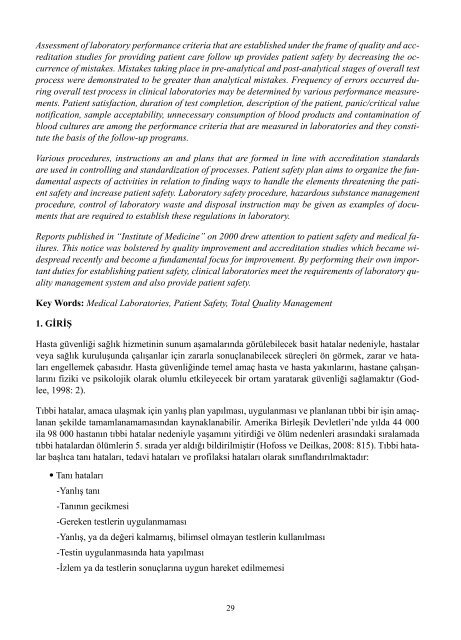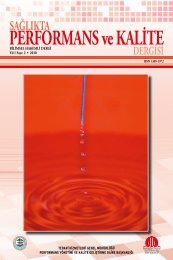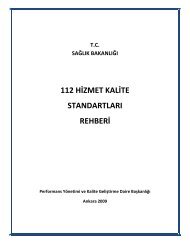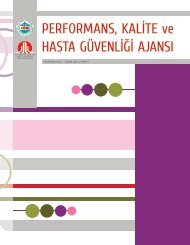- Page 1 and 2: T.C. SAĞLIK BAKANLIĞI TEDAVİ Hİ
- Page 3 and 4: KONGRE BAŞKANI Prof. Dr. Nihat TOS
- Page 5 and 6: KONGRE BİLİM KURULU Doç. Dr. İs
- Page 7: Prof. Dr. Musa EKEN Sakarya Üniver
- Page 10 and 11: En İyi Uygulama Ödülü” yarı
- Page 12 and 13: Alev Akın, Aliye Şen Üçel, Nurs
- Page 14 and 15: Hacer Soydan, Ali Arslanoğlu Bir E
- Page 16 and 17: Gaye Aydın, Hakan Doğan, Deniz K
- Page 19 and 20: EĞİTİM VE ARAŞTIRMA HASTANELER
- Page 21 and 22: narak İstanbul ilindeki iki eğiti
- Page 23 and 24: Tablo 2. Çalışanların meslekte,
- Page 25 and 26: “Birimdeki Takım Çalışması
- Page 27 and 28: Sağlık kuruluşlarında çalışa
- Page 29 and 30: services quality and patient safety
- Page 31 and 32: • Sağlık hizmetlerini ödeyen k
- Page 33 and 34: Anket örneği aşağıda verilmiş
- Page 35 and 36: Hasta güvenliği konusu Almanya’
- Page 37 and 38: lında kabul edilen bir kanuna gör
- Page 39 and 40: Aşağıda yer alan şema da bunu i
- Page 41 and 42: 6. TÜRKİYEDE HASTA GÜVENLİĞİ
- Page 43: TIP LABORATUARLARINDA HASTA GÜVENL
- Page 47 and 48: sonuçta kuruluşların mükemmel i
- Page 49 and 50: taları azaltmak için alınması g
- Page 51 and 52: 2.2.3. Testlerin Sonuçlanma Süres
- Page 53 and 54: 2.4. Laboratuar Güvenliği Laborat
- Page 55 and 56: GÜVENLİ HASTANELER VE İLETİŞİ
- Page 57 and 58: To decrease the risks related with
- Page 59 and 60: 2.4. Kamu ve Özel Hastane Oranı V
- Page 61 and 62: 1: Denizli 2: Artvin 3: Ankara 4: K
- Page 63 and 64: Grafik 6. S3 ile diğer değişkenl
- Page 65 and 66: Grafik 10. S5 ile diğer değişken
- Page 67 and 68: Özel hastanelerde, hastane enfeksi
- Page 69 and 70: Ortaokul mezunu kişilerin daha ço
- Page 71 and 72: Bu da bir algılama sorusu olmakla
- Page 73 and 74: HASTANELERDE HASTA GÜVENLİĞİ İ
- Page 75 and 76: • Verimli sunulan sağlık hizmet
- Page 77 and 78: Bu çalışmanın öncelikli amacı
- Page 79 and 80: 4. ARAŞTIRMANIN BULGULARI Tablo 1.
- Page 81 and 82: Tablo 3. Sağlık çalışanların
- Page 83 and 84: • Acil - ameliyathane ve diğer (
- Page 85 and 86: HASTA GÜVENLİĞİ KÜLTÜRÜNÜ B
- Page 87 and 88: vurgulanması ve tüm çalışanlar
- Page 89 and 90: MEDİKAL KALİBRASYONUN HASTA GÜVE
- Page 91 and 92: • Geçmişteki kaza ve vakalara g
- Page 93: gönüllülük esasına dayandığ
- Page 97 and 98:
HASTA GÜVENLİĞİ KÜLTÜRÜ: BUR
- Page 99 and 100:
Number of years of the functioning
- Page 101 and 102:
• “Hasta güvenliği”, •
- Page 103 and 104:
söylenmeli, hekim istemi yazmadan
- Page 105 and 106:
ların özellikle düşmelerin önl
- Page 107 and 108:
5. HASTA GÜVENLİĞİ KÜLTÜRÜ
- Page 109 and 110:
Faktör Cronbach Alpha C: İletişi
- Page 111 and 112:
hasta ile temas arasında da anlaml
- Page 113 and 114:
KAYNAKLAR Akalın, H.Erdal (2007),
- Page 115 and 116:
tient safety, there must be suffici
- Page 117 and 118:
3. BULGULAR 3.1. Hasta Güvenliği
- Page 119 and 120:
3.2.8. Hasta Güvenliği İçin Has
- Page 121 and 122:
SAĞLIK ORTAMINDA ÇALIŞANLARDA G
- Page 123 and 124:
1. GİRİŞ Çalışmak yaşamın b
- Page 125 and 126:
suzluğu, statü düşüklüğü ol
- Page 127 and 128:
Tablo 6. Çalışanların Stres Olu
- Page 129 and 130:
GİRESUN PROF. DR. A. İLHAN ÖZDEM
- Page 131 and 132:
• Yöneticiler, çalışanlar ve
- Page 133 and 134:
HEDEFLER Toplam Puan % Bebek kaçı
- Page 135 and 136:
Değerlendirme tablosunun incelemes
- Page 137 and 138:
1.Değerlendirme 2.Değerlendirme K
- Page 139 and 140:
KAYNAKLAR Akalın, H. Erdal.(2004),
- Page 141 and 142:
esult, it has been seen that nurses
- Page 143 and 144:
için, konuyla ilgili kavramsal lit
- Page 145 and 146:
Tablo 3’e göre, araştırmaya ka
- Page 147 and 148:
Tablo 5 de görüleceği üzere, Kr
- Page 149 and 150:
Tablo 7’de görüleceği üzere,
- Page 151 and 152:
ÖĞRENCİ HEMŞİRELERİN HASTANE
- Page 153 and 154:
2.4 Bulgular Tablo 1. Öğrenci hem
- Page 155 and 156:
elerin en yakın çalıştığı me
- Page 157:
GÜVENLİ HASTANELER VE İLETİŞİ
- Page 160 and 161:
1. GİRİŞ Mobbing, Latince’de k
- Page 162 and 163:
sında da genellikle zorbalık yapa
- Page 164 and 165:
Çalışmalara bakıldığında, mo
- Page 166 and 167:
naklandığını belirtmesi bulgula
- Page 168 and 169:
SAĞLIK ÇALIŞANLARININ YILDIRMAYA
- Page 170 and 171:
neltilen zorbalık ve taciz davran
- Page 172 and 173:
İngiltere’de yapılan suç araş
- Page 174 and 175:
Tablo 1. Yıldırma ölçeğinin (L
- Page 176 and 177:
Yıldrımaya Olası Yıldırma Davr
- Page 178 and 179:
fif şiddet uygulanır” (%3,5) da
- Page 180 and 181:
pılan Bir Araştırma. Doktora Tez
- Page 182 and 183:
1. GİRİŞ Hasta hakları sağlık
- Page 184 and 185:
hastaların sağlık hizmeti sürec
- Page 186 and 187:
ği bir kişi tarafından alınır.
- Page 188 and 189:
Hastaneler CİNSİYET Özel Devlet
- Page 190 and 191:
Tablo 4. Hasta hakları birimine ş
- Page 192 and 193:
Tablo 8. Hastaların şikayet bildi
- Page 194 and 195:
Özel hastanede, hastaların şikay
- Page 196 and 197:
SAĞLIKLI İLETİŞİM VE İLETİŞ
- Page 198 and 199:
Yapılan çalışmalar, hemşireler
- Page 200 and 201:
lik görevlisi olduğu görülmüş
- Page 202 and 203:
Araştırmaya katılanlara iş orta
- Page 204 and 205:
Anket katılımcılarının sorular
- Page 206 and 207:
Anket katılımcılarının sorular
- Page 208 and 209:
geliştirilmesinin özel önemi var
- Page 210 and 211:
HASTA GÜVENLİĞİ KÜLTÜRÜ, İ
- Page 212 and 213:
1.3. Performans Örgütsel davranı
- Page 214 and 215:
2.4.1. Güvenirlik Analizi Bu çal
- Page 216 and 217:
ve anlamlı ilişkiler bulunduğu t
- Page 219 and 220:
SAĞLIK TEKNOLOJİSİ YÖNETİMİND
- Page 221 and 222:
tenance and repair activities. Cons
- Page 223 and 224:
• Satıcı/donatım yönünden de
- Page 225 and 226:
• Açıklamalar ve düzenlemelerd
- Page 227 and 228:
• Talep edilen donatımı kullan
- Page 229 and 230:
şılayamayan hastaneler yararlanab
- Page 231 and 232:
ması için, Sağlık Bakanlığı
- Page 233 and 234:
HATA TÜRLERİ ve ETKİLERİ ANALİ
- Page 235 and 236:
uygun olarak, KLD doğrudan hastan
- Page 237 and 238:
Şekil 1. KLD ile ilgili birbirini
- Page 239 and 240:
Tablo 4. Temel ve alt süreçler i
- Page 241 and 242:
3. BULGULAR KLD ile ilgili 6 temel
- Page 243 and 244:
Şekil 5. Temel süreç-3 kapsamın
- Page 245 and 246:
Şekil 7. Temel süreç-5 kapsamın
- Page 247 and 248:
Tablo 5. KLD bildirme sürecinde HT
- Page 249 and 250:
7 Kritik sonuçları bildirecek ola
- Page 251 and 252:
Şekil 10. Biyokimya laboratuarınd
- Page 253 and 254:
Şekil 13. Kritik laboratuar değer
- Page 255 and 256:
Wagar, Elizabeth A.-Friedberg, Rich
- Page 257 and 258:
hospital directly to the quality un
- Page 259 and 260:
AÇILAN UYGUNSUZLUK SAYISI 2009 yı
- Page 261 and 262:
DENİZLİ DEVLET HASTANESİNDE RİS
- Page 263 and 264:
2.1.4. Sorumluluk Tüm birim soruml
- Page 265 and 266:
İş Yerine ve Çevreye Yönelik Ri
- Page 267 and 268:
No İSTENENLER YAPILANLAR 15 Diyali
- Page 269 and 270:
Ek 1. Risk Değerlendirme Formu Rİ
- Page 271 and 272:
HACETTEPE ÜNİVERSİTESİ TIP FAK
- Page 273 and 274:
In the current study we analyzed th
- Page 275 and 276:
nadian Paediatric Triage and Acuity
- Page 277 and 278:
Şekil 2. Çocuk Acil Ünitesi’ne
- Page 279:
GÜVENLİ HASTANE UYGULAMALARI
- Page 282 and 283:
4.Çalışanların tesis güvenliğ
- Page 284 and 285:
1. TESİS YÖNETİMİNİN PLANLANMA
- Page 286 and 287:
Şekil 1. Şiddet puanı bulma örn
- Page 288 and 289:
2.2. Tatbikatlar Yeditepe Üniversi
- Page 290 and 291:
HASTANELERİN AFET PLANLARI VE AFET
- Page 292 and 293:
gerçekleştirilebilmesi için öne
- Page 294 and 295:
2. YÖNTEM 2.1. Amaç Araştırma,
- Page 296 and 297:
Tablo 3. Anket formunu yanıtlayan
- Page 298 and 299:
Tablo 5. Anket sorularına verilen
- Page 300 and 301:
Tablo 6’nın Devamı: Anket sorul
- Page 302 and 303:
Tablo 5’de anket sorularına veri
- Page 304 and 305:
AMELİYATHANE VE ANESTEZİ SONRASI
- Page 306 and 307:
mechanical engineer, primarily arch
- Page 308 and 309:
Ameliyathane bölümü sistemi; kli
- Page 310 and 311:
Günümüz teknolojisi ameliyat oda
- Page 312 and 313:
Ameliyathane havasında mikroorgani
- Page 314 and 315:
farklılık gösterir. Ameliyathane
- Page 316 and 317:
tamın dışında bulundurulmalıd
- Page 318 and 319:
Doğal ışık kaynağının çalı
- Page 320 and 321:
Ameliyathanelerde kullanılacak suy
- Page 322 and 323:
alanları, personel soyunma odası,
- Page 324 and 325:
fon, bilgisayar donanımı ve posta
- Page 326 and 327:
düklerinden daha fazla oranda ve b
- Page 328 and 329:
Temiz oda sistemlerin denetimi kont
- Page 330 and 331:
KAMU SAĞLIK KURUMLARINDA YENİ Sİ
- Page 332 and 333:
2.2. Görüntülerin Saklanması ve
- Page 334 and 335:
eleri vs.) de içerir. Bu bilgi ver
- Page 336 and 337:
Sağlık Bakanlığının da çok
- Page 338 and 339:
Yatırımların geleceğe yönelik
- Page 340 and 341:
5.2.2. Personel Genel olarak rutin
- Page 342 and 343:
İstatiski açıdan kayıt ve kontr
- Page 344 and 345:
let kurumları ortaya çıkacaktır
- Page 346 and 347:
1. GİRİŞ Önce “zarar verme”
- Page 348 and 349:
5 6 7 8 9 10 11 12 Bu birimde çal
- Page 350 and 351:
hatalar bölümde pozitif değisikl
- Page 352 and 353:
SIRA NO 1 2 3 SORULAR Bir hata yap
- Page 354 and 355:
SIRA NO 10 11 SORULAR Hastalar içi
- Page 356 and 357:
ler birimlerde, hasta güvenliği g
- Page 359:
HASTA VE ÇALIŞAN MEMNUNİYETİ
- Page 362 and 363:
se duties. The legislation that is
- Page 364 and 365:
• Sürdürülebilirlik: ülke ko
- Page 366 and 367:
Değişkenler n % Meslek Doktor Sa
- Page 368 and 369:
ASM ve TSM çalışanlarının %76,
- Page 370 and 371:
Grafik 7. Sağlık personelinin ça
- Page 372 and 373:
Grafik 10. Sağlık personelinin ai
- Page 374 and 375:
Sağlık çalışanlarının aile h
- Page 376 and 377:
KAYSERİ İLİ DEVELİ İLÇESİ’
- Page 378 and 379:
Aile hekimliği uygulamasında sağ
- Page 380 and 381:
on Education for Family Practice of
- Page 382 and 383:
Tablo 1. Aile hekimliğinden hizmet
- Page 384 and 385:
Grafik 2. Hizmet alan vatandaşlar
- Page 386 and 387:
Tablo 2 ‘den de görüleceği üz
- Page 388 and 389:
Tablo 3. Katılımcılara göre çe
- Page 390 and 391:
lığı merkezlerinin denetlenmesi
- Page 392 and 393:
sitesi Sosyal Bilimler Enstitüsü
- Page 394 and 395:
1. GİRİŞ Hasta güvenliği, sağ
- Page 396 and 397:
ihtiyacı azaltarak, bilgi girişin
- Page 398 and 399:
Tablo 1. Hastane hasta güvenliği
- Page 400 and 401:
Tablo 3. Hastane hasta güvenliği
- Page 402 and 403:
analiz edecek bir sistem geliştirm
- Page 404 and 405:
Ek 1. Hastane Hasta Güvenliği Kü
- Page 406 and 407:
Abstract Satisfaction concept in de
- Page 408 and 409:
2.2. Araştırma Gereci Araştırma
- Page 410 and 411:
Hastanenin fiziki koşulları ile i
- Page 412 and 413:
Çalışan Memnuniyeti İle İlgili
- Page 414 and 415:
Hastane yöneticileri açısından,
- Page 416 and 417:
BİNGÖL İLİ 112 ACİL SAĞLIK H
- Page 418 and 419:
Şekil 1. 112 Acil sağlık hizmetl
- Page 420 and 421:
lam vaka sayısı 916.918 iken topl
- Page 422 and 423:
yenidoğan hastalıkları, %1.67’
- Page 424 and 425:
son sırada gelmektedir. Devlet İs
- Page 427:
HASTA GÜVENLİĞİ UYGULAMALARI
- Page 430 and 431:
Örneklem: Araştırma çok kültü
- Page 432 and 433:
In this study, the KMO analysis res
- Page 434 and 435:
1.3. Hastane Enfeksiyonları Tanı
- Page 436 and 437:
1.7. Yanlış Ya da Uygun Olmayan M
- Page 438 and 439:
Faktör analizi yapılırken ilk a
- Page 440 and 441:
Maddeler Faktör Yükü Maddeler Fa
- Page 442 and 443:
Bileşenler IV kateterlerin kalma s
- Page 444 and 445:
Envanterin yapı geçerliliğinin b
- Page 446 and 447:
Kaushal R, Bates DW, Landrigan C, M
- Page 448 and 449:
REHABİLİTASYON HASTANESİNDE HAST
- Page 450 and 451:
i müdahale sırasındaki hata ve k
- Page 452 and 453:
Birimdeki Görev Süresi 1 yıldan
- Page 454 and 455:
Tablo 4. Meslek grupları arasında
- Page 456 and 457:
Eğer bir sağlık kurumu, güvenli
- Page 458 and 459:
SAĞLIK ÇALIŞANLARININ HASTA GÜV
- Page 460 and 461:
Hastaya zarar vermeden güvenli sa
- Page 462 and 463:
Hastane müdahaleleri ve değişim
- Page 464 and 465:
Araştırma gurubunun hasta güvenl
- Page 466 and 467:
Bu birimde oluşan hatalar hakkınd
- Page 468 and 469:
Olumlu yanıtların meslek gruplar
- Page 470 and 471:
Pızzı L, Goldfarb N, Nash D. Prom
- Page 472 and 473:
place in both careful treatment and
- Page 474 and 475:
dönüşlere sebep olacağı, endi
- Page 476 and 477:
Şekil 1. Sözel order telefonla ka
- Page 478 and 479:
4.2. Ses Kayıt Dönemine Ait Veril
- Page 480 and 481:
Hastanın tedavisi ve ilaç kullan
- Page 482 and 483:
Görüşmelerin az da olsa hala bir
- Page 484 and 485:
With systematically observation, an
- Page 486 and 487:
suzlukların diğer yıllara göre
- Page 488 and 489:
Grafik 4. 2004 - 2009 hasta güvenl
- Page 490 and 491:
Dünya Sağlık Örgütünün (WHO)
- Page 493:
SAĞLIK HİZMETLERİNDE KALİTE VE
- Page 496 and 497:
ce quality putting into use the req
- Page 498 and 499:
Hastane hizmetlerinden müşteri be
- Page 500 and 501:
si ( ) %5 olarak alınmıştır. An
- Page 502 and 503:
Tablo 2. Hasta veya yakının servi
- Page 504 and 505:
2 = 7,92 (Olasılığı: 0,019) olu
- Page 506 and 507:
ği tespit edilmiştir. Ayrıca, so
- Page 508 and 509:
3.3.4. AS’lerin Seviye, Triaj ve
- Page 510 and 511:
mu, müşahede odalarının fiziki
- Page 512 and 513:
YATAN HASTALARDA BESİN-İLAÇ ETK
- Page 514 and 515:
Tablo 1. İlacın etkisini etkileye
- Page 516 and 517:
ilaçların etkinliği de azalmakta
- Page 518 and 519:
↑ serum seviyesinde yağlı yiyec
- Page 520 and 521:
Tablo 6. Gıda alerjisi bulunan has
- Page 522 and 523:
Grafik 3. Kullanılan ilaç sayıs
- Page 524 and 525:
Hastaların klinikte yattığı sü
- Page 526 and 527:
“Besin-İlaç Etkileşimleri List
- Page 528 and 529:
PAŞABAHÇE DEVLET HASTANESİ’NDE
- Page 530 and 531:
sağlık çalışanlarının sağl
- Page 532 and 533:
Tablo 1’de görüldüğü gibi ar
- Page 534 and 535:
de yaptıkları çalışmalarında
- Page 536 and 537:
Tablo 9. Sağlık personelinin çal
- Page 538 and 539:
4. SONUÇ Paşabahçe Devlet Hastan
- Page 540 and 541:
Sağlık Problemlerinin İncelenmes
- Page 542 and 543:
İnsan hayatı söz konusu olduğun
- Page 544 and 545:
McDIARMID’ e göre sağlık hizme
- Page 546 and 547:
Sağlık kurum ve kuruluşlarında
- Page 548 and 549:
yapılmıştır. Kolmogrov Smirnov
- Page 550 and 551:
Grafik 4. Örneklem grubunun toplam
- Page 552 and 553:
Hastanenin güvenlik düzeyinin rap
- Page 554 and 555:
Tablo 15. Raporlama sıklığı ile
- Page 556 and 557:
Tesis güvenliğinin sağlanması v
- Page 558 and 559:
1. GİRİŞ J.M. Juran kaliteyi “
- Page 560 and 561:
Araştırma evrenini; Bingöl ilind
- Page 562 and 563:
Grafik 3. Hasta ve çalışan güve
- Page 564 and 565:
Omachanu V., (1991). Total Quality
- Page 567 and 568:
GİRESUN PROF. DR. A.İLHAN ÖZDEM
- Page 569 and 570:
Kaynak ayırmalı, Eğitimlerin sü
- Page 571 and 572:
İfadeler Kesinlikle Katılmıyorum
- Page 573 and 574:
ildirmişlerdir. Ankara’da yapıl
- Page 575 and 576:
Tablo 6. Raporlanmış olayların s
- Page 577 and 578:
Hastalar için en iyi bakımı sağ
- Page 579 and 580:
Institute of Medicine: Crossing the
- Page 581 and 582:
It’s obvious that, quality applic
- Page 583 and 584:
Katılımcıların Eğitim Durumlar
- Page 585 and 586:
ilen önem, ayrılan zaman ve sayg
- Page 587 and 588:
GİRESUN İLİ HASTANELERİNDE HAST
- Page 589 and 590:
HEDEFLER Değerlendirilen Kriter Sa
- Page 591 and 592:
Grafik 3. Sağlık kurumlarının h
- Page 593 and 594:
ANESTEZİ YOĞUN BAKIM ÜNİTESİND
- Page 595 and 596:
• Anestezik, sedatif, analjezik v
- Page 597 and 598:
Tablo 1. Norton skalası Puan: ≤
- Page 599 and 600:
2.2. Bulgular ve Tartışma 2008 y
- Page 601 and 602:
Beğer T (2004) “Yoğun bakımda
- Page 603 and 604:
and employee under control by incre
- Page 605 and 606:
“Hastanemizde hasta ve çalışan
- Page 607 and 608:
ADSM HİZMET KALİTE STANDARTLARINI
- Page 609 and 610:
Bu anlamda, ülke genelinde sağlı
- Page 611 and 612:
Tablo 1. ADSM hizmet kalite standar
- Page 613 and 614:
Grafik 5. Enfeksiyonların kontrol
- Page 615 and 616:
Grafik 9. Afetler ve olağan dış
- Page 617 and 618:
Tedavi tepsisinde kullanılan antis
- Page 619 and 620:
Veriler bilgisayar ortamında SPSS
- Page 621 and 622:
SAĞLIK HİZMETLERİ SUNUMU SÜREC
- Page 623 and 624:
ifade etmektedir. Geniş anlamda t
- Page 625 and 626:
4. SONUÇ Tıbbi cihaz kavramının
- Page 627 and 628:
Sosyal Güvenlik kurumlarının 200
- Page 629 and 630:
Ulusal düzeyde bir tek sosyal güv
- Page 631 and 632:
Sosyal güvenlik kurumlarının bü
- Page 633 and 634:
“2002’den bu yana kamunun sağl
- Page 635 and 636:
Çalışanların Finansmana Katılm
- Page 637 and 638:
Ödemelerin sınıflandırılması:
- Page 639 and 640:
Sağlığa zararlı gıda ve katkı
- Page 641 and 642:
HEMŞİRELERİN MESLEĞE KARŞI PRO
- Page 643 and 644:
The total MPTE point in this survey
- Page 645 and 646:
Veriler bilgisayar ortamında SPSS
















